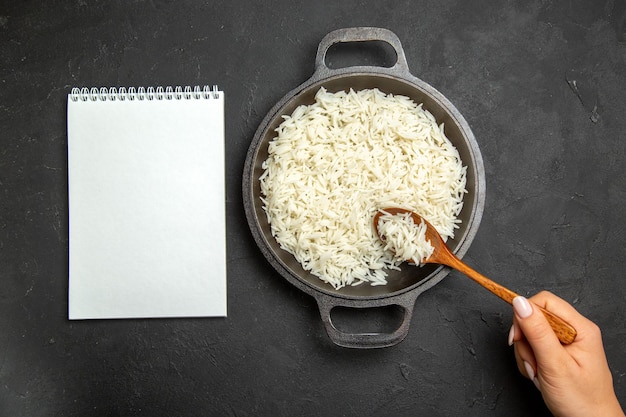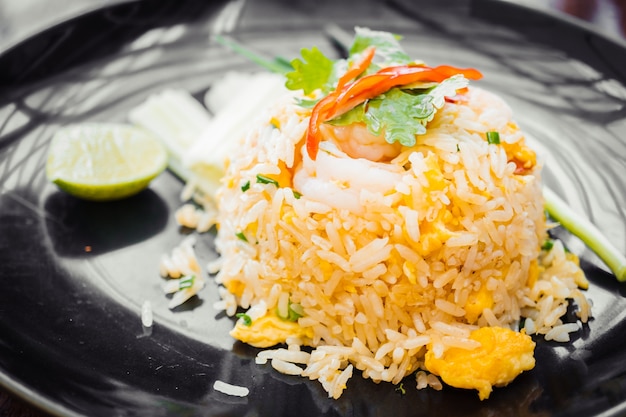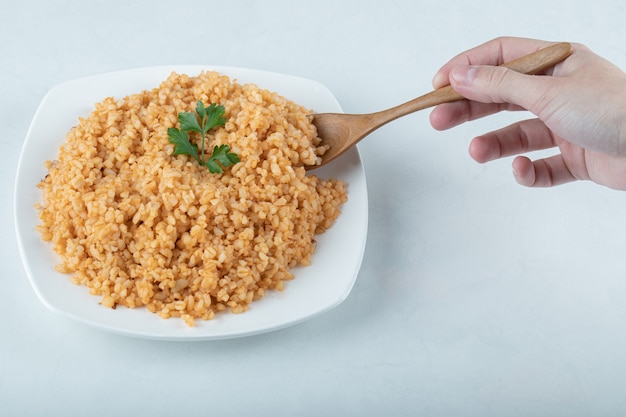fried rice, that humble dish of stir-fried rice and whatever's in the fridge, is a true culinary chameleon. It can be a quick weeknight supper, a comforting takeaway treat, or the star of a fancy dinner party. But let's be honest, sometimes that takeaway fried rice just doesn't hit the spot. It can be greasy, bland, or just plain mushy. That's why I'm here to share my secrets to making the best fried rice, the kind that will have you licking your plate and craving for more.
(Part 1) The Foundations: Cooking the Rice

Like any good building, the foundation of delicious fried rice is the rice itself. And when it comes to rice, there are a few key things to remember. Firstly, it's all about the type of rice. I've been through countless varieties, and for fried rice, my heart belongs to basmati. It's got that wonderful fluffy texture, with those long, slender grains that separate beautifully, and a subtle aroma that just makes you feel good. Plus, it’s the champion of soaking up all those delicious flavours we'll be adding later.
Then there's the cooking. If you're lucky enough to have a rice cooker, you're basically a hero. Just follow the instructions, and you'll have perfect rice every time. But, if you're a pan-cooking warrior like me, you need to be a bit more attentive. My tried and true method is a 1:1 ratio of water to rice. Bring the water to a rolling boil, chuck in the rice, turn the heat down to a simmer, cover the pan, and let it do its thing for about 15 minutes. Just keep an eye on it, you want the rice to be cooked through, but not mushy. And once it's done, give it a good fluff with a fork to prevent any clumpy behaviour.
The Importance of Cooling and Drying:
Now, you might be thinking, "I've cooked the rice, I'm ready to fry!" But hold your horses. There’s a secret ingredient that makes all the difference – cooling. Let the rice cool completely before you even think about frying it. Why? Because it helps it firm up, preventing it from turning into a mushy mess in the pan.
But there's more. After the rice has cooled, we need to dry it out. We don’t want any moisture hanging around, making our fried rice soggy. To do this, I usually spread it out on a baking sheet and leave it at room temperature for about an hour, letting all the extra moisture evaporate.
I know, I know, it seems like extra work, but trust me, it’s worth the effort. You'll be rewarded with the most satisfying fried rice, every grain separate, delightfully crisp, and ready to absorb all those delicious flavours.
(Part 2) The Ingredients: A Symphony of Flavours

The beauty of fried rice is that it's like a blank canvas for your taste buds. You can use whatever ingredients you have on hand, and it will still taste amazing. But there are a few ingredients that I consider essential, the ones that form the foundation of my perfect fried rice.
The Essential Ingredients:
- Eggs: scrambled eggs are my absolute non-negotiable in fried rice. They add a richness and creaminess that you just can't get without them. And I'm all about that perfect egg curd texture, so I usually scramble them separately and then stir them into the rice at the end.
- Soy Sauce: A good quality soy sauce is essential for that salty, savory flavour that makes fried rice so addictive. I usually use a combination of light and dark soy sauce to get a well-balanced flavour.
- Oyster Sauce: This is my secret weapon, the flavour booster that adds depth and a hint of sweetness. A little goes a long way, just a tablespoon or two is enough to transform the dish.
- Garlic and Ginger: These aromatics are like the lifeblood of any good fried rice. They add a punch of freshness and flavour, a zing that wakes up your taste buds. I usually mince them finely before I toss them into the pan.
- Vegetables: This is where you can really get creative! I always have chopped onions, carrots, and peas on hand, but feel free to experiment. bell peppers, mushrooms, tofu, bok choy – the possibilities are endless.
The "Secret" Ingredient:
Now, I'm not one for keeping secrets, but this one's a game changer: MSG! Yes, I know, it's a bit controversial, but hear me out. A tiny pinch of MSG can amplify the savoury flavour, making everything taste more delicious. It's called umami for a reason!
If you're still hesitant about MSG, you can try a vegetarian alternative like seaweed or mushrooms. They contain naturally occurring glutamates and can provide a similar umami boost.
(Part 3) The Process: Bringing It All Together

Alright, we've got our foundation, we've got our flavour symphony – now it's time for the grand finale. This is where the real magic happens, the moment of truth.
The Steps:
- Heat the Oil: Grab your favourite large pan or wok, and crank up the heat to medium-high. Add a generous amount of oil, enough to coat the bottom of the pan. We want it nice and hot for those delicious crispy bits.
- Add the Aromatics: Toss in your minced garlic and ginger, be careful not to burn them. You just want to release those aromatic oils, that delicious scent that makes your mouth water.
- Add the Vegetables: Now, it’s time for your chosen vegetables. Give them a good stir-fry for a few minutes, until they’re slightly tender, but still have a bit of crunch.
- Add the Rice: Pour in that perfectly cooled and dried rice. Stir-fry it for a few minutes, making sure to break up any clumps. You want it to be evenly coated with the oil and those amazing aromas.
- Add the Sauce: Now it's time for the flavour bomb. Add your soy sauce, oyster sauce, and that tiny pinch of MSG (or your preferred umami booster). Give it a good stir, allowing the flavours to meld and dance together.
- Add the Eggs: And finally, the grand finale – those pre-scrambled eggs. Stir-fry everything for another minute or two until the eggs are cooked through and the rice is nice and hot.
The Art of Stir-Frying:
Stir-frying is the key to success here. It’s all about keeping those ingredients moving, preventing them from sticking to the pan, and ensuring that every grain of rice is coated in the delicious sauce. Use a spatula or a wooden spoon, and move with purpose, ensuring that everything gets a good toss.
Don't be afraid to get a little messy, the best stir-fry masters have a little bit of sauce splattered on their aprons. Just keep those ingredients moving, and you'll be on your way to fried rice perfection.
Taste and Adjust:
Before you serve your masterpiece, take a bite and make sure the seasoning is just right. You may need to add a bit more salt, soy sauce, or even a sprinkle of sugar if it’s too sour. Don't be afraid to experiment and adjust the seasoning to your liking. It’s your creation, after all.
(Part 4) Embracing Variety: The Endless Possibilities
Remember, I said fried rice is a chameleon. It adapts to your tastes and your ingredients. Here are a few ideas to inspire your next culinary adventure.
Flavour Variations:
- Thai Fried Rice: Skip the soy sauce and embrace the bold flavours of fish sauce and lime juice. Add some chopped cilantro and chilies for a spicy kick. You'll be transported to a Thai street food stall with every bite.
- Kimchi Fried Rice: Bring a touch of Korean flavour with a spoonful of kimchi. It’s a tangy, spicy, and fermented wonder that adds a whole new dimension to fried rice.
- Chinese Sausage Fried Rice: Add some diced Chinese sausage (lap cheong) for a smoky, salty flavour that will make you want to grab a second helping.
- Shrimp Fried Rice: Add some cooked shrimp for a protein boost and a taste of the sea.
- Chicken Fried Rice: Use leftover chicken or roasted chicken for a hearty and satisfying meal.
Other Ingredient Variations:
- Pineapple Fried Rice: Add some chunks of pineapple for a touch of sweetness and a tropical flavour.
- Mushroom Fried Rice: Use a variety of mushrooms like shiitake, oyster, and button mushrooms for a delicious umami explosion.
- Tofu Fried Rice: Add some cubed tofu for a vegetarian option that's packed with protein and flavour.
(Part 5) Serving Suggestions: Taking It to the Next Level
Now you've created your perfect fried rice, but how do you make it even more amazing? Let's talk about serving it up right.
Serving Size:
Fried rice is usually served as a main course, but it can also be enjoyed as a side dish. A typical serving size is about 1 cup, enough to satisfy your hunger without leaving you feeling stuffed.
Serving Temperature:
Fried rice is best served hot. To keep it warm, you can serve it straight from the pan, or transfer it to a serving dish and keep it warm in the oven.
Garnishes:
A sprinkle of chopped green onions or cilantro can add a pop of colour and freshness to your fried rice. You can also add a fried egg on top for an extra dose of protein and a beautiful visual.
side dishes:
Fried rice pairs well with a variety of side dishes. Here are a few ideas to complete your meal:
- Soup: A light and flavorful soup, like a miso soup or a wonton soup, is a great way to start your meal and cleanse your palate.
- Salad: A simple salad with a light dressing can help balance out the richness of the fried rice.
- Pickled Vegetables: Pickled vegetables, like kimchi or pickled ginger, add a tangy and crunchy contrast to the fried rice.
(Part 6) Leftovers: From Delicious to Even More Delicious!
Sometimes, we get carried away and make more fried rice than we can eat in one sitting. But, don’t worry, leftovers are a good thing. They’re even more delicious the next day. It's the perfect dish to have on hand for a quick and easy lunch or dinner.
Just make sure to store your leftover fried rice in an airtight container in the fridge and enjoy it within a day or two.
Reheating:
Here are a few ways to reheat your leftover fried rice.
- Microwave: This is the fastest and easiest way to reheat fried rice. Just place it in a microwave-safe dish and heat on high for 1-2 minutes, or until it’s hot.
- Stovetop: For a crispier texture, you can reheat the fried rice on the stovetop. Heat a tablespoon of oil in a pan over medium heat, add the fried rice, and stir-fry for a few minutes until it’s heated through.
- Oven: For a larger batch of fried rice, you can reheat it in the oven. Preheat the oven to 350 degrees F (175 degrees C) and spread the fried rice on a baking sheet. Bake for 10-15 minutes, or until it’s heated through.
(Part 7) Fried Rice Beyond the Plate: The Fun Stuff
You've mastered the art of perfect fried rice. But why stop there? Fried rice isn’t just for dinner. It can be enjoyed in many different ways. Let’s get creative!
Fried rice bowls:
Fried rice bowls are a fun and trendy way to enjoy this dish. It’s like a deconstructed version of fried rice, allowing you to customize your meal. You can layer your fried rice with other ingredients like avocado, kimchi, pickled ginger, or even a fried egg, creating a unique and satisfying meal.
Fried Rice Wraps:
For a portable and satisfying meal, try wrapping your fried rice in a tortilla or a rice paper wrapper. Add some extra fillings like shredded chicken, tofu, or vegetables for a complete meal.
Fried Rice Fritters:
Let's get adventurous. Turn your leftover fried rice into delicious fritters. Simply shape the rice into patties, dip them in batter, and fry them until they’re golden brown. Serve them with a dipping sauce for a truly delicious snack or appetizer.
Fried rice salad:
For a lighter and more refreshing option, try making a fried rice salad. Mix your fried rice with a variety of fresh vegetables, a light dressing, and a sprinkle of toasted sesame seeds for a satisfying and healthy meal.
(Part 8) FAQs: Your Burning Questions Answered
Even the most seasoned chefs have questions, so let's tackle some of the most common questions about fried rice.
FAQs:
- Q: Can I use leftover cooked rice from the night before?
A: Absolutely! leftover rice is perfect for fried rice. The starch in the rice will have had time to dry out, giving it that ideal fluffy texture.
- Q: What if I don’t have any leftover rice?
A: No worries! You can cook some fresh rice specifically for your fried rice. Just make sure to cool it completely before using it.
- Q: Can I use any kind of rice for fried rice?
A: While basmati rice is my go-to, you can use other types of rice as well. jasmine rice or even brown rice work well, but keep in mind that they might have a slightly different texture.
- Q: What kind of oil should I use?
A: A neutral oil like vegetable oil or canola oil is best for fried rice. You can also use sesame oil, but be careful not to use too much, as it can overpower the other flavours.
- Q: How long does fried rice last in the fridge?
A: Fried rice will last in the fridge for 3-4 days, but it’s best enjoyed within a day or two for optimal flavour and texture.
(Part 9) A Final Thought: The Journey to Perfect Fried Rice
Making the perfect fried rice is a journey, not a destination. It's about experimenting, discovering what works for you, and embracing the endless possibilities.
So, the next time you're looking for a quick and delicious meal, don’t hesitate to grab that leftover rice and create your own masterpiece. Trust me, you won’t be disappointed.
Everyone is watching

Prime Rib Roast Cooking Time Chart: Per Pound Guide
Cooking TipsPrime rib roast. Just the name conjures images of lavish dinners, crackling fires, and hearty laughter. It’s ...

How Long to Bake Potatoes in the Oven (Perfect Every Time)
Cooking TipsBaked potatoes are a staple in my kitchen. They're incredibly versatile, delicious, and surprisingly easy to m...

Perfect Rice Every Time: The Ultimate Guide to Cooking Rice
Cooking TipsAs a self-proclaimed foodie, I've always been a bit obsessed with rice. It's the foundation of countless cuisi...

The Ultimate Guide to Cooking Asparagus: Tips, Techniques, and Recipes
Cooking TipsAsparagus. The mere mention of this spring delicacy conjures up images of vibrant green spears, crisp and burs...

Ultimate Guide to Cooking the Perfect Thanksgiving Turkey
Cooking TipsThanksgiving. Just the word conjures up images of overflowing tables laden with delicious food, the scent of r...
